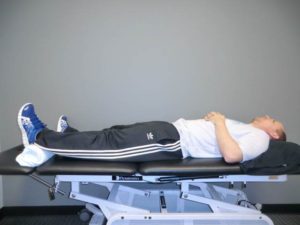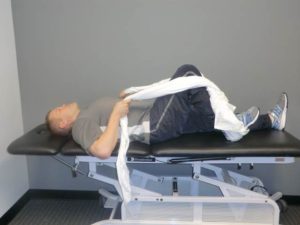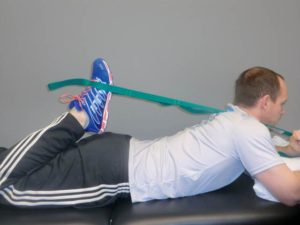7 Things You Gotta Have for ACL Rehab
We see lots of people with anterior cruciate ligament (ACL) reconstructions. ACL rehab after surgery is a long, arduous process that takes several months. Unfortunately, the internet is a sea of misinformation on what to do/not to do. It’s littered with various experts, horror stories, and various pundits who all have a different take, which adds to confusion. Complicating matters further is that everyone seems to want to base outcomes on a professional athlete’s outcomes, or be committed to the idea that it has to be a specific time frame, commonly 6 months, prior to return to sport after ACL surgery. Your ACL rehab should be a collaboration with you, your operating surgeon, and your sports physical therapist. So what are the key things you need to have for ACL rehab?
Keys to ACL Rehab
Get your knee as straight as possible as soon as possible. This is critical for proper muscle function as well as normal walking, and for you athletes, running eventually. Studies have found as little as a 3° loss of extension adversely affects function, so make sure this is a priority.
Get your quad muscle working. In order to walk, it is imperative that your quads work correctly. These are the muscles on the front of your thigh. These are the muscles you contract when you stretch in the morning and extend your knees. As soon as you are able after surgery, you should start “setting” the muscle with brief contractions to get it firing. Think of it almost like a heart beating. A nice tool to help with this is a muscle stimulator. Multiple studies have shown that a muscle stimulator on the quads helps subjects improve gait and quad functioning than those that don’t.
Maximize your bending as much as your physician allows. Try not to let that knee get too stiff. Doing either heel slides, sitting at the edge of the bed, or using a bike for range of motion only are some ways you could do it. Your doctor may get you a Continuous Passive Motion (CPM) machine but studies show it is not required.
Use a crutch/es until you are walking completely normal! This one is huge. Amazingly, many physicians tell people to ditch the crutches and then watch them walk out of the office limping. This may be our biggest pet peeve with physicians. All eliminating the crutches does is keep your knee swollen, inhibit your quad, and delay your recovery. Even if you don’t need two crutches, use one on the opposite side of the surgery (yes, the OPPOSITE side) or even a cane until you are walking completely normal. Trust us – you’ll thank us later.
Focus on single leg training. Several studies have shown that after ACL reconstruction, subjects unconsciously unload their involved leg up to a year after surgery doing squats on both legs. Furthermore, they even unload their leg two years after surgery when landing from a box to floor jump. So, even though you think you’re symmetrically distributing weight, you are really not. Therefore, you should focus your ACL rehab on single leg movements for most of your rehab. We’re not saying “don’t do squats” but we are saying that you’ll likely cheat anyway, so make that involved side work doing single leg activities. (And by the way, we really emphasize eccentric training of the quads to help get those babies stronger and they won’t give you that anterior knee pain that many people get after patellar tendon grafts, but you’ll have to come see us to learn more about that!).
You must get your thigh muscle mass no more than 1 cm difference than your non-injured leg. Many people who have chronic trouble with their involved leg long after surgery is often due to not getting their quad mass back. Persistent pain, swelling, and dysfunction ultimately affect their function. Many physical therapists fail to actually measure thigh mass throughout the course of rehab. An analogy is having no shocks on a car, or having half inflated tires. What do you think would happen with either of these scenarios? The car would break down faster and have problems. Well, your knee is no different. This may take a year or so after surgery to get back, but someone should keep checking throughout your ACL rehab process.
Don’t forget about the hamstrings! In real estate circles, people talk about “curb appeal.” Make the house look nice in front – new paint, trimmed bushes, a nice freshly cut lawn. Then you look at the backyard. May be a disaster. The focus on making the thigh muscle bigger neglects the critical hamstrings. For the recovering athlete with an ACL reconstruction, your hamstrings are your best friend. They are the “brakes” that limit the risk of the ACL being torn. Therefore, make sure you do lots of stiff leg deadlifts, exercise ball bridges, ball curls, leg curls, and the Nordic hamstring curl as part of your ACL rehab.
You have two legs, balance training needs to be on both legs. Humans are a bipedal species – we walk and run on both feet. Balance after an ACL reconstruction is impaired and needs to be a part of your rehab. Why on earth would you only do balance work on one leg? Usually, deficits that may have caused your ACL tear are present bilaterally. Therefore, what you do on one, do on the other.
Get your heel to your butt! This is critical for people that want to play sports again. When you run, your heel needs to get all the way to your glutes to sprint correctly. Many athletes get their “active” range of motion back (what they can do), but lack the “passive” range. The passive range is the “extra” range when you pull. This is illustrated when you stretch your quads. If you lift your heel up to try and touch your glute, it can’t get all the way up. That’s the active range. When you grab your foot and pull it up to your glute, that’s the passive part – the “leftover” slack. You have to have that to run right. If not, you won’t be as fast, and you’re at risk for hamstring strains. There are many techniques to get this back, and it’s more than just cranking on it till it gets there. You should wait several months before you aggressively stretch.
Make sure you get tested before you get “cleared.” The biggest mistake doctors make is telling patients they’re “cleared” without explaining the difference between being “medically” cleared and “physically” cleared. Unfortunately, it puts the idea in the patient’s head that he’s good to go. The doctor clears you medically. They tell you that your new ACL is healed and you have no infections or any reason to stop training/progressing. However, physical readiness is totally different. It shocks me how many people get “cleared” to practice/play when no one has ever watched them cut, sprint, or jump on one leg. At a very minimum, you should have your strength tested and perform a series of single leg functional tests to make sure that your involved leg is at least 90% of your uninvolved one before getting released. Once you do that, then you are “physically” cleared. We promise, our functional testing algoithm is thorough and specific. You will always know where you are in the continuum of recovery.
Of course, there’s a lot more detail and nuances that we didn’t discuss here, but these are non-negotiable. We see lots of people after ACL surgery that need rehab after. We speak to PT’s all over the U.S on how to rehab these the right way – our experts are “right in your backyard” so give us a call! It would be a privilege to partner with you in your care.
Tags: ACL rehab, Kansas City, Overland Park, physical therapy after ACL surgery, prairie village, rehab after ACL surgery, sports physical therapist, sports physical therapy



